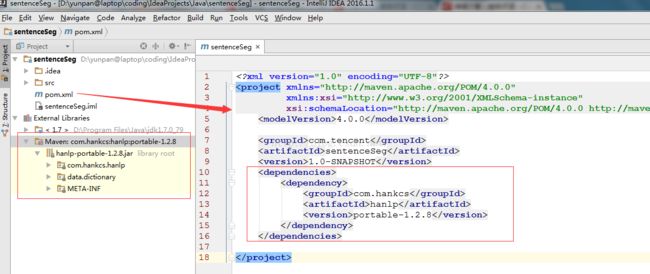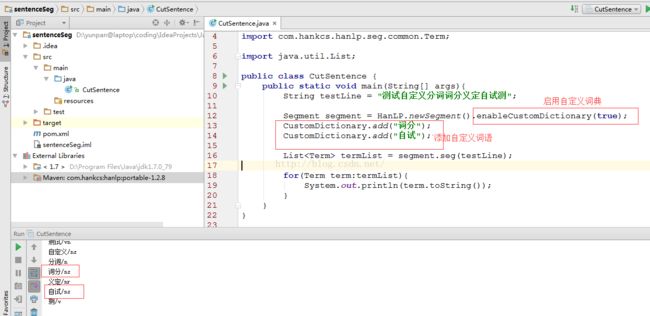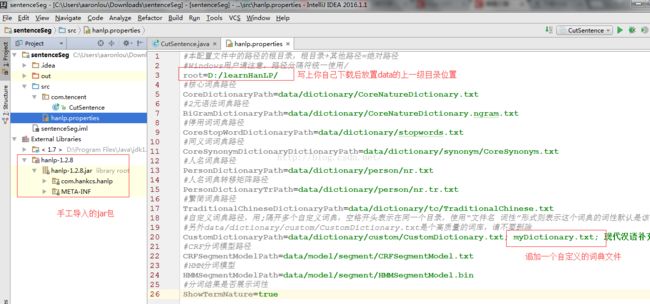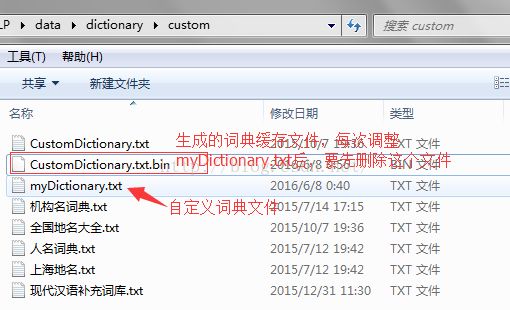基于hanLP的中文分词详解-MapReduce实现&自定义词典文件
前言
文本分类任务的第1步,就是对语料进行分词。在单机模式下,可以选择python jieba分词,使用起来较方便。但是如果希望在Hadoop集群上通过mapreduce程序来进行分词,则hanLP更加胜任。
一、使用介绍
hanLP是一个用java语言开发的分词工具, 官网是 http://hanlp.linrunsoft.com/index.html。 hanLP创建者提供了两种使用方式,一种是portable简化版本,内置了数据包以及词典文件,可通过maven来管理依赖,只要在创建的 maven 工程中加入以下依赖,即可轻松使用(强烈建议大家优先采用这种方法)。
com.hankcs
hanlp
portable-1.2.8
具体操作方法如图示,在pom.xml中,加入上述依赖信息,笔者使用的IDEA编辑器就会自动开始解析依赖关系,并导入左下角的hanlp jar包。
二、通过第一种方法,建立maven工程,编写mapreduce完整程序如下(亲测运行良好):
import com.hankcs.hanlp.HanLP;
import com.hankcs.hanlp.dictionary.stopword.CoreStopWordDictionary;
import com.hankcs.hanlp.seg.Segment;
import com.hankcs.hanlp.seg.common.Term;
import org.apache.hadoop.conf.Configuration;
import org.apache.hadoop.conf.Configured;
import org.apache.hadoop.fs.Path;
import org.apache.hadoop.io.IntWritable;
import org.apache.hadoop.io.LongWritable;
import org.apache.hadoop.io.Text;
import org.apache.hadoop.mapreduce.Job;
import org.apache.hadoop.mapreduce.Mapper;
import org.apache.hadoop.mapreduce.lib.input.FileInputFormat;
import org.apache.hadoop.mapreduce.lib.input.TextInputFormat;
import org.apache.hadoop.mapreduce.lib.output.FileOutputFormat;
import org.apache.hadoop.mapreduce.lib.output.TextOutputFormat;
import org.apache.hadoop.util.GenericOptionsParser;
import org.apache.hadoop.util.Tool;
import org.apache.hadoop.util.ToolRunner;
import java.io.IOException;
import java.util.List;
public class SentenceSeg extends Configured implements Tool {
public static class segMapper extends Mapper {
public void map(LongWritable key, Text value, Context context) throws IOException,InterruptedException {
Text textSentence = new Text();
String line = value.toString();
String[] strSplits = line.split("\t");
if(strSplits.length == 2) {
int label = Integer.parseInt(strSplits[0]);
String sentence = strSplits[1];
Segment segment = HanLP.newSegment().enablePartOfSpeechTagging(false);
List segWords = segment.seg(sentence);
CoreStopWordDictionary.apply(segWords);
String strSegWords = segWords.toString().replaceAll("[\\[\\]]", "").replaceAll("\\/[a-z]+,", "");
textSentence.set(strSegWords.toString());
System.out.println("---------------------------");
System.out.println(segWords.size());
System.out.println(strSegWords);
System.out.println("---------------------------");
context.write(new IntWritable(label), textSentence);
}
}
}
public int run(String[] args) throws Exception{
Configuration conf = new Configuration();
String[] otherArgs = new GenericOptionsParser(conf, args).getRemainingArgs();
System.out.println("----------------------");
System.out.println(otherArgs.length);
for(int i=0;i ");
System.exit(2);
}
Job job = Job.getInstance(conf);
job.setJobName("credit_text_classify");
job.setJarByClass(SentenceSeg.class);
Path input = new Path(otherArgs[0]);
Path output = new Path(otherArgs[1]);
FileInputFormat.addInputPath(job, input);
FileOutputFormat.setOutputPath(job, output);
job.setMapperClass(segMapper.class);
job.setInputFormatClass(TextInputFormat.class);
job.setOutputFormatClass(TextOutputFormat.class);
job.setNumReduceTasks(0);
job.setMapOutputKeyClass(IntWritable.class);
job.setMapOutputValueClass(Text.class);
job.setOutputKeyClass(IntWritable.class);
job.setOutputValueClass(Text.class);
System.exit(job.waitForCompletion(true)?0:1);
return 0;
}
public static void main(String[] args) throws Exception {
int res = ToolRunner.run(new Configuration(), new SentenceSeg(), args);
System.exit(res);
}
} 三、添加自定义词典文件 & 单机模式
有时候我们希望根据自己业务领域的一些专有词汇进行分词,而这些词汇可能并不包含在官方jar包自带的分词词典中,故而我们希望提供自己的词典文件。首先,我们定义一个测试的句子,并用系统默认的词典进行分词,可看到效果如下图所示:
假设在我们的专业领域中,“词分”,“自试” 都是专业术语,那么使用默认词典就无法将这些目标词分出来了。这时就要研究如何指定自定义的词典,并在代码中进行调用。这时有2种方法。
1. 在代码中,通过CustomDictionary.add();来添加自己的词汇,如下图所示, 可以看到这次分词的结果中,已经能将“词分”,“自试” 单独分出来了。
2. 假如说我们想添加的词汇较多呢,通过上面的方法,一个一个 add, 未勉显得不够优雅,这时我们就希望通过一个词典文件的形式来添加自定义词汇。在官方网站上,提供了如下一种方法。该方法要求我们单独下载一个data目录,以及定义一个配置文件。下面我们就来看下如何操作。
首先,下载好上面的hanlp.jar后,在java工程师导入该包。同时在src目录下创建一个hanlp.properties配置文件,内容直接复制官网上的内容,但是注意修改两个地方。
其中myDictionary.txt是我们自己创建的一个词典文件,其内容为:
词分
自试这时候,再运行方法1同样的代码,可看到如下结果中,也将“词分”、“自试” 分了出来。
注意,如果你不想显示/n /nr这样的记性,也可以将上述配置文件中最后一行
ShowTermNature=trueShowTermNature=false注意,这时候,运行成功的话,会在词典目录下生成一个词典缓存文件
四、自定义词典文件 & mapreduce提交
写到这里,想必细心的人已经想到了,当我们希望将编辑好的mapreduce程序打成jar包,提交到集群上运行时,上面这种通过配置文件指定data目录的方法还可行吗? 反正我是没有搞定。理论上,要么我们需要把data上传到集群上每个节点,要么把data直接打到jar包中。但是,这两种方法本人尝试都没有成功。最终,跟一位同事相互讨论后,借鉴了对方的方法。即我们猜想,portable版本自带了data数据,且不需要额外指定配置文件。而我们现在想做的就是添加了一些自定义词汇,那么,是否我们将其中的词典缓存文件替换掉,就行了呢?
动手试下才知道嘛。这次不通过maven来管理依赖,直接下载portable版本的jar包,然后打开压缩文件,删除data\dictionary\custom目录下的CustomDictionary.txt.bin文件,然后将上一步运行成功的CustomDictionary.txt.bin粘贴进去! 将工程打成jar包,再通过命令行进入其所在目录,执行java -jar 包名, 发现可以执行成功。然后,为了测试是否对这个绝对路径有依赖,我们故意将该jar包剪切到 d:\ , 再执行一下,发现同样是成功的。
具体到提交到集群上运行,我们就不赘述了。这个方法虽然土一些,但至少是可用的。
PS:吐槽一下,hanLP的官方文档写得真不够亲民,很多过程讲得不清不楚。






